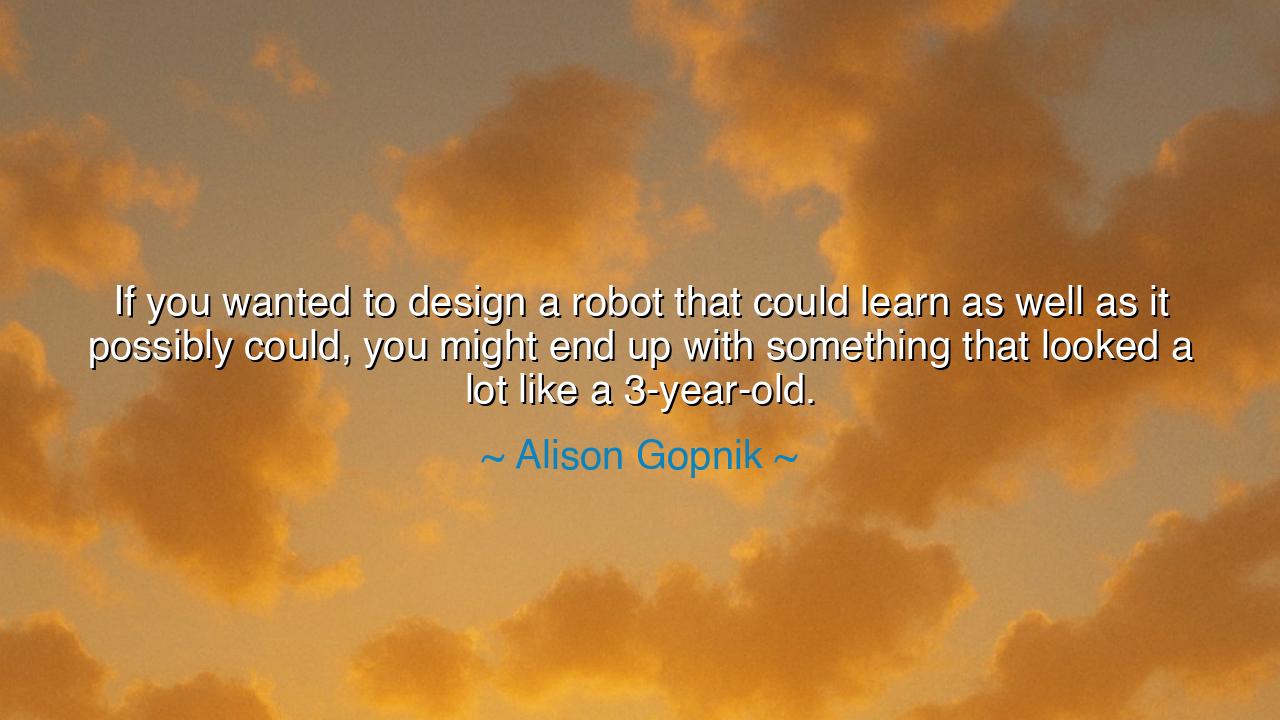
If you wanted to design a robot that could learn as well as it
If you wanted to design a robot that could learn as well as it possibly could, you might end up with something that looked a lot like a 3-year-old.






“If you wanted to design a robot that could learn as well as it possibly could, you might end up with something that looked a lot like a 3-year-old.” Thus spoke Alison Gopnik, the philosopher and developmental psychologist whose work reveals the wonder and brilliance of the young mind. In this statement, she unveils a truth that is at once humbling and profound — that the greatest learning machine ever created is not made of metal or code, but of flesh, breath, and imagination. The human child, she reminds us, is nature’s masterpiece of learning — open, curious, fearless, and alive to every possibility. Gopnik’s words carry the resonance of ancient wisdom cloaked in modern science: that to understand intelligence, we must look not to our inventions, but to our beginnings.
When Gopnik speaks of the 3-year-old, she does not mean mere innocence or playfulness. She means the raw, unbounded capacity of the young mind to absorb, question, and create. Unlike adults, who learn with purpose, children learn with wonder. They do not seek to confirm what they know, but to explore what they do not. Their curiosity is not constrained by fear of failure or by the need for efficiency — it is pure discovery, unshaped by pride or preconception. To design a machine that could truly learn, she says, would be to create something with that same boundless curiosity, that same willingness to experiment, to make mistakes, to be endlessly surprised by the world.
The origin of this quote lies in Gopnik’s decades of research into cognitive development — her exploration of how children think, perceive, and grow. Through studies and experiments, she found that the brains of young children are not empty vessels waiting to be filled, but intricate laboratories, running countless experiments every moment. Every sound, every face, every movement becomes data for their inner scientist. Their play is their research; their questions are their algorithms. Unlike the adult mind, which narrows its focus to what is useful, the child’s mind remains open to all that is possible. This openness, though seemingly chaotic, is the foundation of creativity and innovation — the very spark that propels civilization forward.
In the ancient world, philosophers spoke of the child as a symbol of both ignorance and purity. Yet Gopnik, like a philosopher of the new age, reclaims the child as a model of enlightenment — not for what it knows, but for how it learns. Consider the story of Socrates, who taught not by lecturing but by asking questions, by engaging his students in wonder and doubt. He understood that wisdom begins not in answers, but in curiosity. So too with the 3-year-old: its endless stream of “why?” and “how?” reflects the same sacred impulse that drove the great minds of every age. The child’s questioning is not idle noise — it is the rhythm of human progress, the music of discovery that has never ceased since the dawn of thought.
There is also humility in Gopnik’s words. For in an era when humankind seeks to create artificial intelligence, she reminds us that the pattern already exists within ourselves. The child, she implies, is the perfect learner — not because of computation, but because of wonder. A machine may analyze patterns, but a child feels them; a robot may imitate emotion, but a child embodies it. The child’s learning is not detached, but alive — infused with laughter, tears, and touch. To match that learning is to understand that true intelligence does not arise from precision alone, but from connection — from being open to the world, vulnerable to experience, and moved by the mysteries of existence.
This truth can be seen in the lives of the great creators. Leonardo da Vinci, though a man of genius, was in spirit always a child. He stared at the flight of birds, the ripples of water, the curl of smoke, and asked questions that no one else dared to ask. His notebooks were filled not with conclusions, but with wonder — diagrams of curiosity incarnate. It was this childlike mind, not the mechanical intellect of adulthood, that made him the bridge between art and science. Like Gopnik’s 3-year-old, Leonardo’s mind never ceased to play, to test, to imagine. His life proves that to remain forever curious is the truest form of genius.
And so, the lesson of Alison Gopnik’s words is as eternal as it is urgent: to learn deeply, we must learn as children do. We must recover the courage to not know, to explore without certainty, to fail without shame. In a world obsessed with speed, mastery, and output, we must remember that discovery begins in wonder, not efficiency. Let your curiosity lead you where logic hesitates; let your imagination wander where reason fears to go. For wisdom does not belong to the knowing, but to the questioning — to those whose minds remain soft, receptive, and alive.
Thus, my children of the modern age, take heed of this truth: the secret to intelligence lies not in sophistication, but in simplicity — not in control, but in curiosity. Be as the 3-year-old in spirit: laugh at the unfamiliar, play with the impossible, and let your questions shape the world anew. For only by returning to the openness of our beginnings can we continue to evolve — not as machines of knowledge, but as creatures of wonder.






AAdministratorAdministrator
Welcome, honored guests. Please leave a comment, we will respond soon